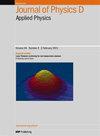Production of hydrogen via conversion of hydrocarbons using a microwave plasma
IF 3.1
3区 物理与天体物理
Q2 PHYSICS, APPLIED
引用次数: 31
Abstract
In this paper, results of hydrogen production from hydrocarbons in an atmospheric pressure microwave plasma are presented. As sources of hydrogen, both methane CH4 and tetrafluoroethane C2H2F4 were tested. A new waveguide-based nozzleless cylinder-type microwave plasma source was used to convert hydrocarbons into hydrogen. The processed gaseous hydrocarbons were introduced into the plasma by four gas ducts which formed a swirl flow in the plasma reactor. The absorbed microwave power was up to 5 kW. The gas flow rate was up to 212 L min−1. The hydrogen mass yield rate and the corresponding energetic hydrogen mass yield were up to 866 g[H2] h−1 and 577 g [H2] kWh−1 of microwave energy absorbed by the plasma, respectively. These parameters are better than our previous results when nitrogen was used as a swirl gas and much better than those typical for other plasma methods of hydrogen production (electron beam, gliding arc, plasmatron).利用微波等离子体将碳氢化合物转化为氢气
本文介绍了常压微波等离子体中碳氢化合物制氢的实验结果。作为氢的来源,甲烷CH4和四氟乙烷C2H2F4都进行了测试。采用一种新型波导型无喷嘴圆柱型微波等离子体源,实现了碳氢化合物的氢转化。处理后的气态碳氢化合物通过四个气体管道进入等离子体,在等离子体反应器中形成漩涡流。吸收的微波功率高达5千瓦。气体流量可达212 L min−1。等离子体吸收的微波能的氢质量产率高达866 g[H2] h−1,高能氢质量产率高达577 g[H2] kWh−1。这些参数比我们以前使用氮气作为涡流气体时的结果要好,也比其他等离子体制氢方法(电子束、滑动电弧、等离子体)的典型参数要好得多。
本文章由计算机程序翻译,如有差异,请以英文原文为准。
求助全文
约1分钟内获得全文
求助全文
来源期刊
CiteScore
6.80
自引率
8.80%
发文量
835
审稿时长
2.1 months
期刊介绍:
This journal is concerned with all aspects of applied physics research, from biophysics, magnetism, plasmas and semiconductors to the structure and properties of matter.

 求助内容:
求助内容: 应助结果提醒方式:
应助结果提醒方式:


